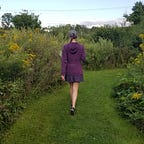Bird-friendly Gardening along the Mississippi Flyway
by Elizabeth Richards, Special Projects and Design Intern
Memphis is home to an abundance of birds, from colorful songbirds to swooping raptors. The city provides an ideal location for naturally occurring and homegrown habitat, especially given its placement along the great Mississippi Flyway. Explore the landscapes of the Memphis River Parks, including the floodplains of Mud Island & Greenbelt Parks, the forested bluff of Ashburn-Coppock Park and the flowering meadows of River Garden to get an idea of how diverse local habitats can be. Take these bird-friendly tips home to make your garden a paradise for winged wildlife. By growing native plants and providing food, water, and shelter, Memphians can create habitat to attract year-round feathered friends!
FOOD SOURCES:
It is essential to provide reliable food sources to attract birds to your garden. While bird feeders with high-quality seed are a popular option, you can plant fruit and seed-bearing trees, bushes, vines and perennials to provide natural food sources. Flowering dogwood, redbud, sumac and our many native oak trees provide a feast for seed-and-fruit loving birds! Bee balm, tulip poplars and salvia produce blooms that attract hummingbirds and other nectar-loving species. Many birds, including sparrows, vireos, and cardinals, feed on insects that thrive in a diverse garden, especially when pesticide and herbicide usage is limited. Attract beneficial bugs like ladybugs, lacewings, and hoverflies by gardening for season-long blooms including plants like yarrow, butterfly weed, asters, and calamint — check out the Pollinator Pod near Beale Street Landing for more gardening inspiration.
SHELTER:
Like us, birds need protection from harsh weather and predators. You can provide safe shelter by growing layered gardens with low perennials, mid-level shrubs and canopy trees. Nesting boxes are also a great option! If you lose a tree or branch in a storm, consider leaving it in a safe place in your garden bed to create singing perches and nesting sites. Woodpeckers love the soft wood of dead trees — consider leaving a snag cut to a safe height for wildlife. Well-manicured open spaces don’t provide much safety, so explore ways to let areas of your garden grow to provide better food variety and shelter for our winged neighbors.
WATER:
Birds need clean water for drinking and bathing, especially as the weather warms. In the Memphis River Parks, birds can be found splashing around in the temporal pools of the Greenbelt Park floodplain and the harbor-edge of the Cobblestone Landing. Access to clean water is vital for birds to stay hydrated and maintain their feathers, which are essential for regulating their body temperature and staying dry. You can create your own bird-friendly oasis right in your own backyard! Whether you build a bird bath or create a shallow pond with flowing water, there are many ways to support our feathered friends. To make it even more inviting, consider adding a few rocks to give birds a place to perch while they take a drink or splash around. Just be sure to refresh the water often to keep it clean and free from algae buildup — your bird visitors will thank you!
NATURAL LANDSCAPE CARE:
Once your garden is filled with diverse plantings, safe shelter and water sources, it’s important to consider the impact that our everyday gardening practices have on creating rich bird habitat. Chemical treatments like pesticides and herbicides can harm birds directly or indirectly, by killing off their food sources. Commonly used landscaping chemicals are known to interrupt the reproductive cycles of ospreys, eagles, and some falcons. This is especially important at this time of year as many birds including ducks, robins, and cardinals are nesting throughout the city. Instead, opt for natural methods of pest control, keep the soil covered with groundcover plants to minimize sprouting weeds and plant a diverse garden to attract beneficial insects & support a healthy food web.
Maintenance timing also matters. Consider a low-mow spring like the Memphis River Parks to attract beneficial insects (and bird food) to your lawns in early spring. Embrace a few weeds in your lawn — dandelions provide habitat too! Consider leaving the seed heads of your garden grasses and flowers up from fall to spring to extend the feast for feathered friends and provide some beautiful garden views of the plants’ winter silhouettes.
A few common Memphis birds and plants that they love!
CARDINALS
Mulberry, flowering dogwood, serviceberry, and fragrant sumac are trees and shrubs that produce delicious seeds and berries for cardinals.
RUBY-THROATED HUMMINGBIRDS
Bee balm, honeysuckle, hardy hibiscus, and azalea provide nectar for hummingbirds. Note their love for tube-shaped flowers and the color red!
DOWNY WOODPECKERS
In addition to the insects that thrive with native plants, woodpeckers feed on the nuts and seeds of serviceberry, dogwood, wild cherry, oak, and purple coneflower.
WHITE THROATED SPARROWS
Sparrows love woody-plants that create thickets like blackberries, sassafras and elderberry, as well as native grasses like switchgrass and little bluestem. These dense environments provide food and shelter for tiny sparrows.
